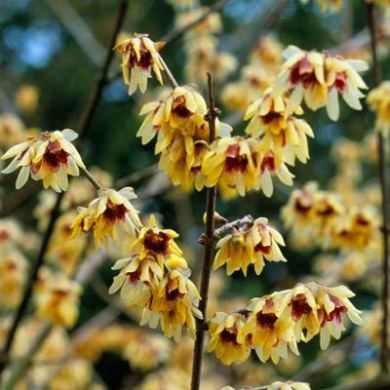
Clematis armandii. http://www.smgrowers.com.
Well its come time to bid farewell to our subtropical friends, as enough outdoor bloomers from the mid-latitudes are now getting going to catch my attention. Clematis armandii is yet another Chinese native, although it blooms a bit later than most of the prior plants in my list. About the time Pink Jasmine and Daphne are wrapping up, this sweet climber is putting all hands on deck. I saw a small one scrambling up some wall in Charleston, South Carolina, years ago on the same trip I saw Pittosporum, and was remembering what I had previously read about the vine from The Fragrant Path before I finally succumbed to my natural instinct to smell it. This clematis, like its brothers in the genus, is vanilla scented. This one is lighter and cleaner scented than Virginia bower, and scarcely less sweet than C. montana; but it is more attractive than any other plant in the genus I have seen to date! Hardy to zone 7 when sequestered in a warm spot, this is definitely a plant for a trellis or fence as its evergreen leaves provide visual interest regardless of the time of year.
Armand clematis blooms its little heart out from late march until mid may, depending on where you live and how warm it gets. Its a good climber, growing up to 15 feet, but not nearly as aggressive as its brother plants, or as heavy as wisteria- so its certainly a liveable companion! Being a woodland inhabitant, it will take shade, but will be robbed of some blooms; although shade will be necessary for its survival in zones 9 and 10. The green leaves are certainly attractive, but too much or too little moisture tends to give them unsightly brown edges, as does too much sun in warm areas. Lastly, there are pink-flowered cultivars available of the genus, which would undoubtedly pair well with Pink Jasmine on a pergola.

Chimonanthus praecox. http://www.jparkers.co.uk.
There are quite a few other late winter bloomers that I have not covered, simply because I haven’t smelled them to give my honest opinion about them. Regrettably, I have not had the chance to smell the wintersweet, (Chimonanthus praecox) which is arguably the hardiest of the subtropical winter bloomers, and the most ethereal of them all. It is reported to be hardy to zone 7, but I have yet to have seen or smelt it anywhere. Its a small shrub with attractive deciduous leaves and a spicy fragrance resembling jonquils and violets according to The Fragrant Path. Its certainly more popular in its native China than here. Other fragrant winter bloomers include Sarcococca, sweet box or winter box, a genus with fragrant blooms in January that are very sweet but short-lived; Viburnum odoratissimum, another Asian bloomer, with a sweet Osmanthus-like fragrance; and Viburnum tinus, Laurustinus, native to the Mediterranean, with a wonderfully sweet fragrance, beautiful evergreen leaves, and a bloom period greater than six months during the dark times of the year.
There are undoubtedly others out there I am not aware of that I will surely find and smell in time. One thing is for sure, fragrance never truly takes a break around the world, even during winter. While those of us from the mid-latitudes have a break during the cold months, we get to relish our greenhouse visits and trips to the south that make every whiff count. With spring now at our doorstep, the southern plants will inevitably continue their bloom in frost-free splendor while fading out, but we northerners are just now beginning our long thaw, and anticipating the sweet bulbs of April. My nose has already sampled scents and are yearning to find more. The new season has begun, slowly spring begins its march towards the longer days of the year, and our senses await to be bombarded. You southerners may have the upper hand for now, but April and May are our months- just you wait!
